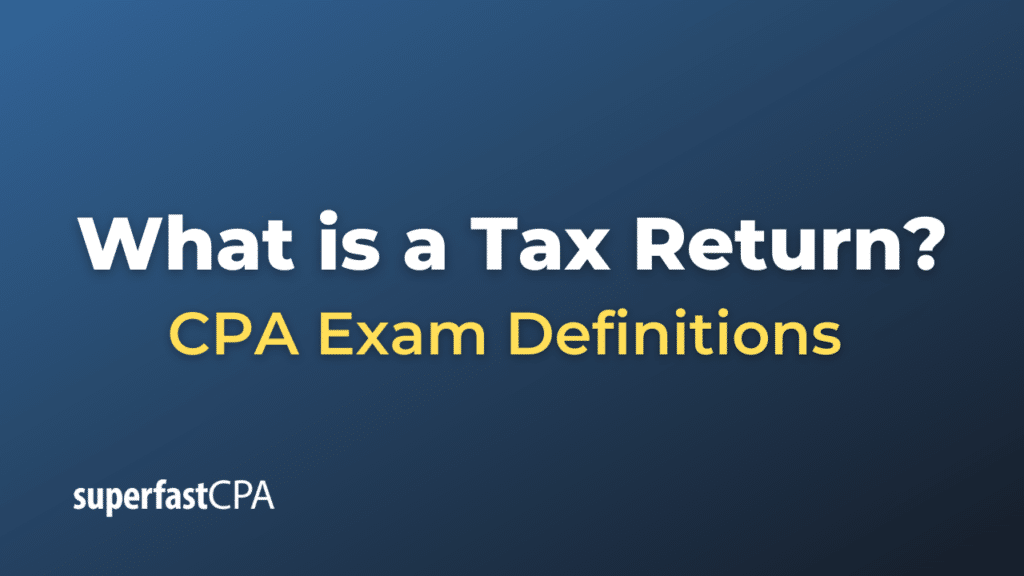Tax Return
A tax return is an official document or form that taxpayers (both individuals and entities) fill out and submit to a tax authority to report their income, calculate their tax liability, and pay any taxes owed. The return also allows taxpayers to claim deductions and credits to reduce their taxable income and overall tax liability.
The specifics of a tax return vary by country, and often by the type of income or activity being reported. Here are some general components that are commonly found in tax returns:
- Identification Information: This includes the taxpayer’s name, address, social security number (or equivalent), and possibly details about their dependents.
- Income Statements: All sources of income during the tax year are reported here. This could include wages, salaries, dividends, interest income, rental income, business profits, and any other earnings.
- Deductions: Taxpayers can reduce their taxable income by claiming various deductions, which might include mortgage interest, student loan interest, medical expenses, charitable contributions, certain business expenses, and more.
- Tax Credits: Credits are amounts that can be directly subtracted from the tax owed. They might be offered for things like educational expenses, energy-efficient home improvements, or for having dependent children.
- Tax Calculation: After accounting for all income, deductions, and credits, the taxpayer calculates their total tax liability.
- Payments and Refunds: If the taxpayer has had more tax withheld or made estimated tax payments throughout the year than they owe, they will be due a refund. If they’ve paid less than they owe, they will have a balance due and must pay the difference.
- Attachments and Schedules: Depending on the taxpayer’s financial situation and activities, they may need to attach additional forms or schedules to their main tax return form. For example, in the U.S., business income might be reported on a Schedule C, while dividend and interest income would be reported on a Schedule B.
In many countries, technological advances have allowed for the electronic filing (e-filing) of tax returns, making the submission process more efficient and faster, especially when it comes to receiving refunds.
It’s important for taxpayers to ensure accuracy when completing their tax returns, as errors or misreporting can lead to penalties, interest charges, or audits by the tax authority. Many individuals choose to seek the assistance of tax professionals or use tax preparation software to help complete and file their returns.
Example of a Tax Return
Let’s walk through a simplified example of a tax return for an individual named Alex, who is filing as a single taxpayer in the U.S.
Alex’s Tax Return:
- Identification Information:
- Name: Alex Johnson
- Address: 123 Main St, Anytown, USA
- Social Security Number: ––***
- Filing Status: Single
- Income Statements:
- Wages from job (reported on W-2 form): $50,000
- Interest from savings account (reported on a 1099-INT form): $200
- Total Income: $50,200
- Deductions:
- Standard Deduction (for a single filer in this example year): $12,400
- Charitable Contributions: $1,000
- Total Deductions: $13,400
- Tax Calculation:
- Using a made-up, simplified tax rate of 15%: $36,800 x 15% = $5,520
- Payments and Refunds:
- Total tax withheld from wages (as reported on the W-2): $6,000
- Since Alex had $6,000 withheld but only owes $5,520, he has overpaid by $480.
- Refund due to Alex: $480
- Attachments and Schedules:
- Alex attaches his W-2 form, which shows his wage income and the tax withheld.
- He also attaches a 1099-INT, which shows his interest income.
After filling out the appropriate tax return form (e.g., Form 1040 in the U.S.) with the above details, Alex would submit it to the IRS. Since he’s due a refund of $480, he can expect the IRS to send him that amount, either by check or direct deposit, depending on his preference.
Please note that this example is highly simplified. In reality, the U.S. tax code is much more complex, with different tax brackets, various deductions and credits available, and multiple other factors that could affect a taxpayer’s situation. Most individuals either use tax software or hire professionals to ensure they’re filing correctly and maximizing their tax benefits.













